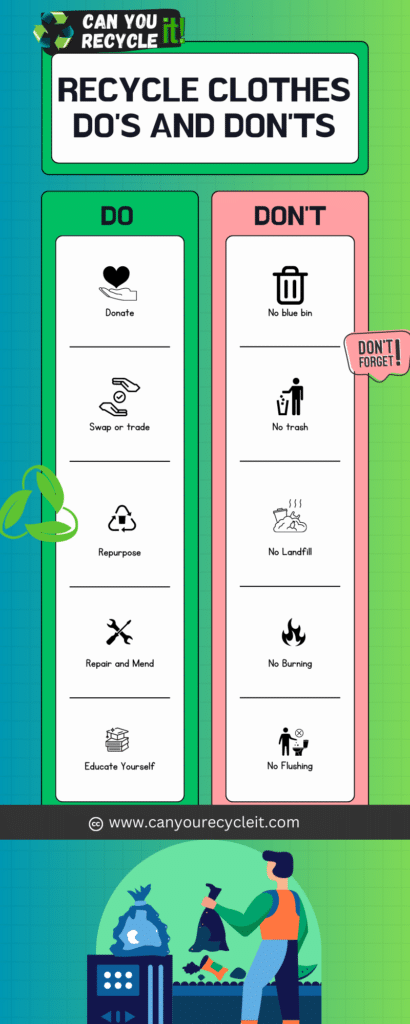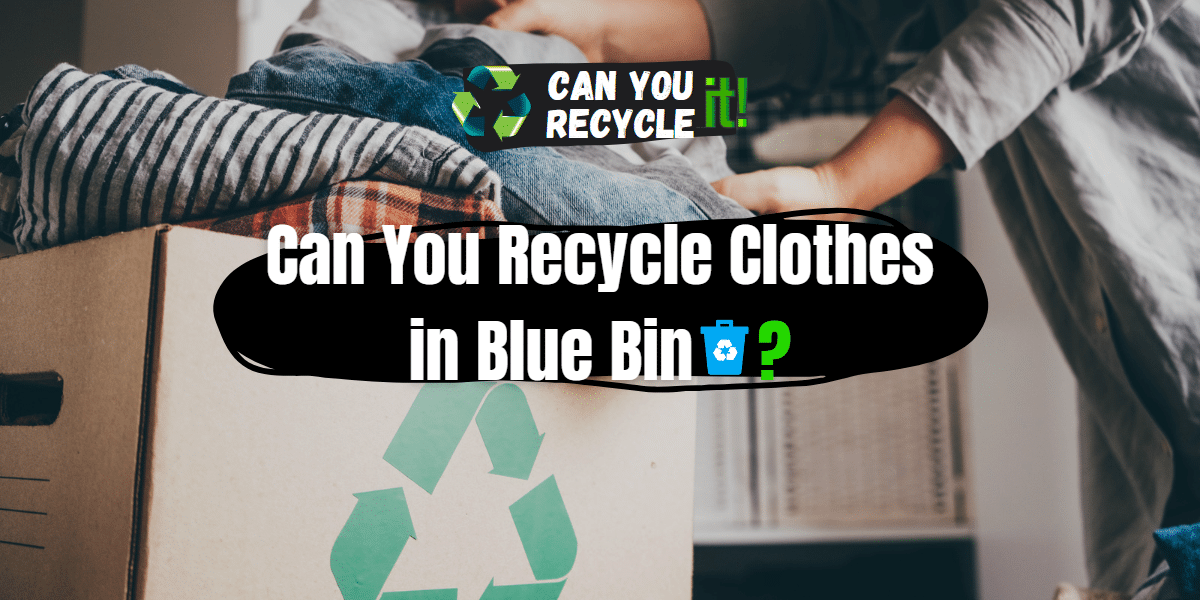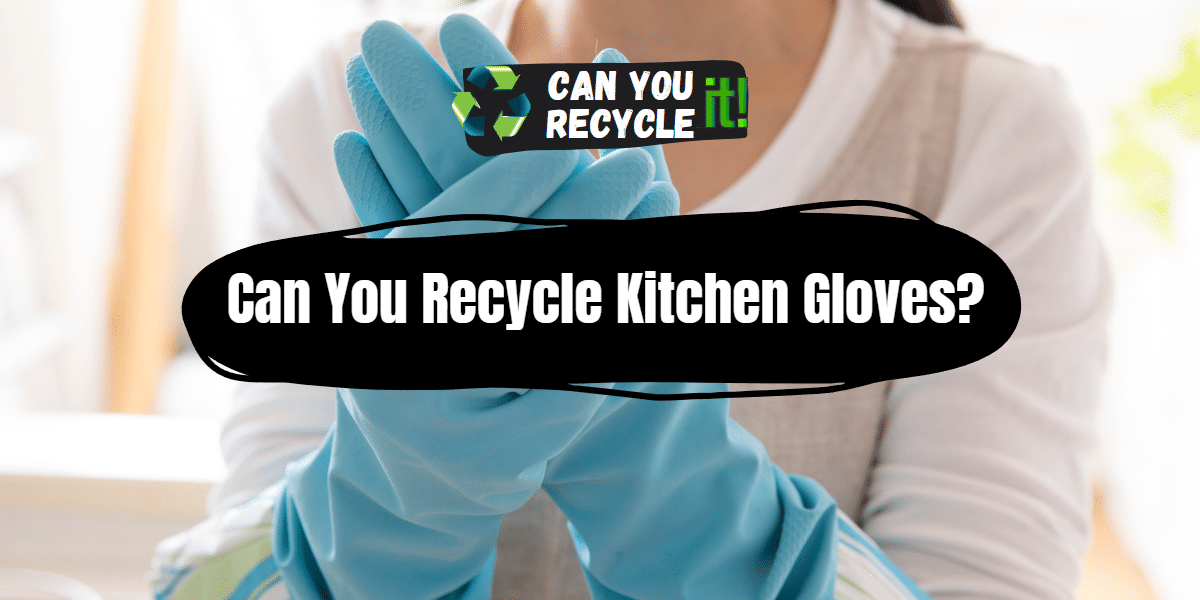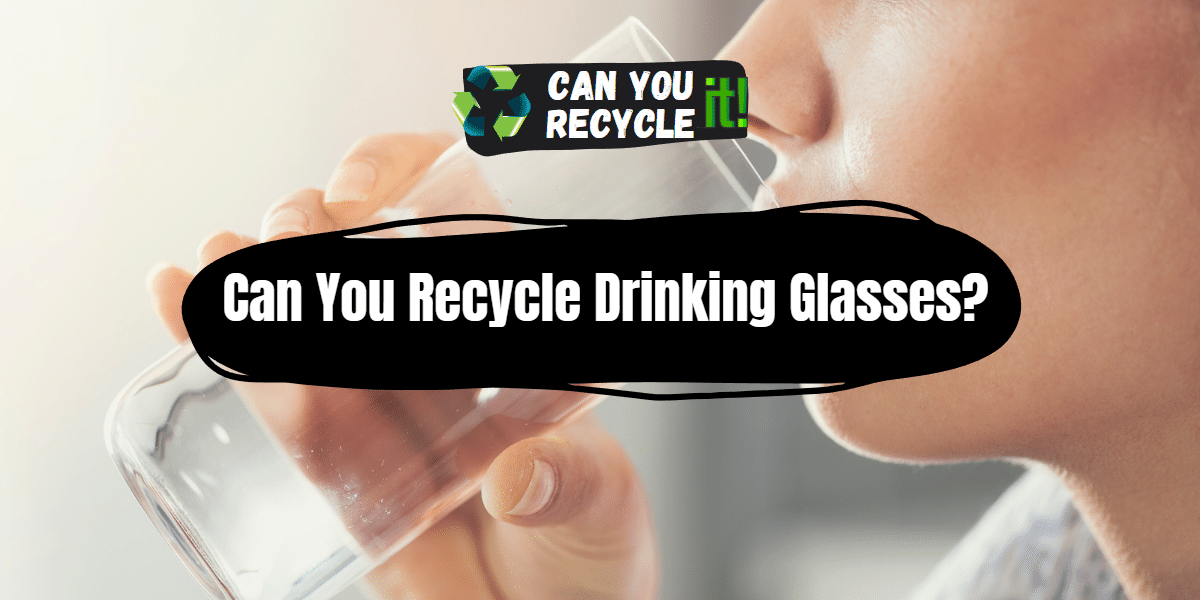Yes, you can recycle clothes, but typically not in the blue bin.
Recycling has become an essential practice in our efforts to protect the environment and reduce waste. While most of us are familiar with recycling common items like paper, plastic, and glass, there is often confusion when it comes to recycling clothes. In this article, we will explore the question: Can you recycle clothes in blue bin? We will provide you with the dos and don’ts of clothing recycling, a step-by-step guide to recycling, answer frequently asked questions, and share some final thoughts on the topic.
While the blue bin is commonly used for recycling household items like paper, cardboard, plastics, and metals, it is not designed to handle textiles such as clothing. However, that doesn’t mean your old clothes have to end up in a landfill. There are other ways to recycle or repurpose them, which we will discuss in more detail.
Table of Contents
Do’s and Don’ts
When it comes to recycling shoes, there are some dos and don’ts to keep in mind. Here are some tips to help you recycle your shoes properly:
Dos
- Donate: Consider donating your gently used clothes to local charities, shelters, or thrift stores. Many organizations accept clothing donations and distribute them to those in need.
- Swap or trade: Participate in clothing swaps or organize a clothing exchange with friends and family. This allows you to refresh your wardrobe without contributing to waste.
- Repurpose: Get creative and find new uses for your old clothes. You can turn t-shirts into reusable shopping bags, use fabric scraps for crafting projects, or transform jeans into stylish shorts.
Don’ts
- Do not put clothes in the blue bin: As mentioned earlier; textiles should not be placed in the blue recycling bin. Clothing can clog recycling equipment and cause issues at recycling facilities.
- Avoid throwing clothes in the trash: While it may be tempting to simply toss old clothes in the trash, this contributes to the growing waste problem. Instead, explore alternative options for recycling or repurposing.
- No Flushing: Never flush clothes down the toilet, as they can cause plumbing issues and harm the sewage system.
5 Step Guide to Recycling Shoes
Here is a brief 5-step guide to recycling shoes.
Step 1
Sort. Begin by sorting your clothes into different categories. Separate items that are in good condition and can be donated from those that are damaged or no longer wearable.
Step 2
Donation. For clothes in good condition, consider donating them to local charities, shelters, or thrift stores. Research organizations in your area that accept clothing donations and find out their requirements and drop-off locations.
Step 3
Repurposing. For damaged or unwearable clothes, explore ways to repurpose them. Cut them into cleaning rags, use them as stuffing for pillows or toys, or create unique home decorations.
Step 4
Textile Recycling Programs. Check if there are any textile recycling programs or drop-off locations in your community. Some organizations specialize in recycling textiles, turning them into new materials or products.
Step 5
Professional Recycling Services. If you cannot find local recycling programs, search for professional recycling services that accept textiles. These services may collect and process clothes on a larger scale, ensuring they are recycled in an environmentally responsible manner.
Tips for Extending Clothes Lifespan
As consumers, we have a significant impact on the environment through our clothing choices. One way to reduce our carbon footprint and contribute to a more sustainable world is by extending the lifespan of our clothes. Not only does this help minimize waste, but it also saves money in the long run. In this blog post, we will share some valuable tips on how you can extend the lifespan of your clothes and make them last longer.
Quality Over Quantity
Invest in high-quality garments made from durable materials. While they may be pricier upfront, they are designed to withstand wear and tear, ensuring longevity. Look for well-constructed pieces with strong seams and quality stitching.
Follow Care Instructions
Take the time to read and follow the care instructions on your clothing labels. Proper washing, drying, and storage techniques can significantly impact the lifespan of your clothes. Avoid harsh washing methods, excessive heat, and over-drying to prevent unnecessary damage.
Gentle Washing
Opt for gentle cycles and use mild detergents when washing your clothes. Harsh chemicals and aggressive washing can weaken fabrics and fade colors. Turn delicate items inside out to protect them from friction and pilling.
Air Dry
Whenever possible, air dry your clothes instead of using a dryer. High heat can cause shrinkage and damage delicate fabrics. Hang or lay your clothes flat to dry to maintain their shape and integrity.
Repair and Mend
Don’t discard clothes at the first sign of wear and tear. Instead, learn basic sewing skills or visit a tailor to mend small holes, loose buttons, or broken zippers. Simple repairs can breathe new life into your favorite garments.
Rotate and Rest
Avoid excessive wear by rotating your clothes regularly. Give each item a break between uses to allow the fabric to recover and reduce strain. This practice prevents premature stretching and fading.
Proper Storage
Store your clothes in a clean, dry, and well-ventilated space. Use appropriate hangers to avoid misshaping and stretching. Fold delicate items and place them in drawers or stack them neatly to prevent snagging.
Layering and Accessories
Extend the versatility of your wardrobe by layering clothes and accessorizing. Pair different pieces to create new outfits and fresh looks. Accessories like scarves, belts, and jewelry can transform a basic outfit into something stylish and unique.
Avoid Overwashing
Not every piece of clothing needs to be washed after every wear. Consider spot cleaning or airing out lightly worn items to maintain their freshness. Overwashing can cause unnecessary wear and fade colors faster.
Donate or Swap
When you no longer need or wear certain items, consider donating them to others or participating in clothing swaps. This gives your clothes a second life and reduces waste.
Infographic:

FAQs for Can you Recycle Clothes in Blue Bin
Can I recycle clothes with holes or stains?
While it’s best to donate clothes in good condition, some textile recycling programs may still accept items with holes or stains. However, it’s recommended to check with the specific recycling service or drop-off location to confirm their requirements.
Can I recycle shoes and accessories along with clothes?
Yes, shoes and accessories like belts and handbags can often be recycled along with clothes. Check with the recycling program or facility to ensure they accept these items.
What happens to the clothes that are recycled?
The process of textile recycling involves sorting, cleaning, and breaking down the materials. Depending on the type of fabric, recycled textiles can be turned into new clothes, insulation material, carpet padding, or even industrial rags.
Are there any alternatives to recycling clothes?
Absolutely! Consider repairing clothes that have minor damage or altering them to give them a fresh look. You can also organize clothing swaps with friends or participate in local swap events to exchange clothes without spending money or generating waste.
Can I recycle clothes through mail-in programs?
Yes, there are mail-in programs available where you can send your old clothes for recycling. These programs provide you with a prepaid shipping label, making it convenient to recycle clothes even if you don’t have local recycling options.
Final Thoughts 💭
While the blue bin may not be the right place to recycle clothes, there are plenty of alternatives available. By donating, repurposing, or utilizing specialized textile recycling programs, you can ensure that your old clothes are given a new lease on life instead of ending up in a landfill. Remember to sort your clothes, separate the wearable from the damaged ones, and explore local donation centers and recycling services. By taking these steps, you contribute to a more sustainable and eco-friendly future.
So, the next time you find yourself wondering whether you can recycle clothes in the blue bin, remember the dos and don’ts we discussed, follow the five-step guide, and make a positive impact on the environment through responsible clothing recycling. Together, we can reduce waste and preserve our planet for future generations.





Leave a Reply